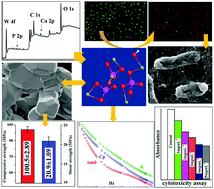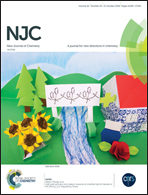Tungsten doped hydroxyapatite processed at different temperatures: dielectric behaviour and anti-microbial properties
Abstract
Hydroxyapatite is regarded as one of the most significant emerging biomaterials owing to its biocompatibility with bone/enamel. In the present study, tungsten doped hydroxyapatite (W-HAp) nanoparticles have been synthesized via chemical precipitation followed by annealing at different temperatures (800, 1000 and 1200 °C) and characterized with XRD and FESEM, along with EDS, TEM, XPS and DTA-TGA. Morphological changes as well as newly formed phases arise in each sample, and the samples also exhibit high mechanical strength and better Young’s modulus as a result of the effects of annealing temperature. The maximum dielectric constant/electric polarization is observed for the W-HAp10 composite, whereas the frequency dependent tangent loss and frequency dependent capacitance are similar for the W-HAp8 and W-HAp12 samples. The anti-bacterial activity of W-HAp10 against Gram-negative (E. coli) and Gram-positive (S. aureus) bacteria has been explored through a mortality assay, MIC (minimum inhibitory concentration), MBC (minimum bactericidal concentration), ROS (reactive oxygen species) generation, fluorescence microscopy, and cell wall degradation under FESEM. The bioactivity of W-HAp10 has been monitored in simulated body fluid (SBF) and is attributable to the formation of apatite on its surface. These significant results suggest that the influence of temperature (at 1000 °C) along with tungsten doping in hydroxyapatite will be beneficial for the advancement of pathogen-free biomaterials with dielectric activity for medicinal applications.



 Please wait while we load your content...
Please wait while we load your content...